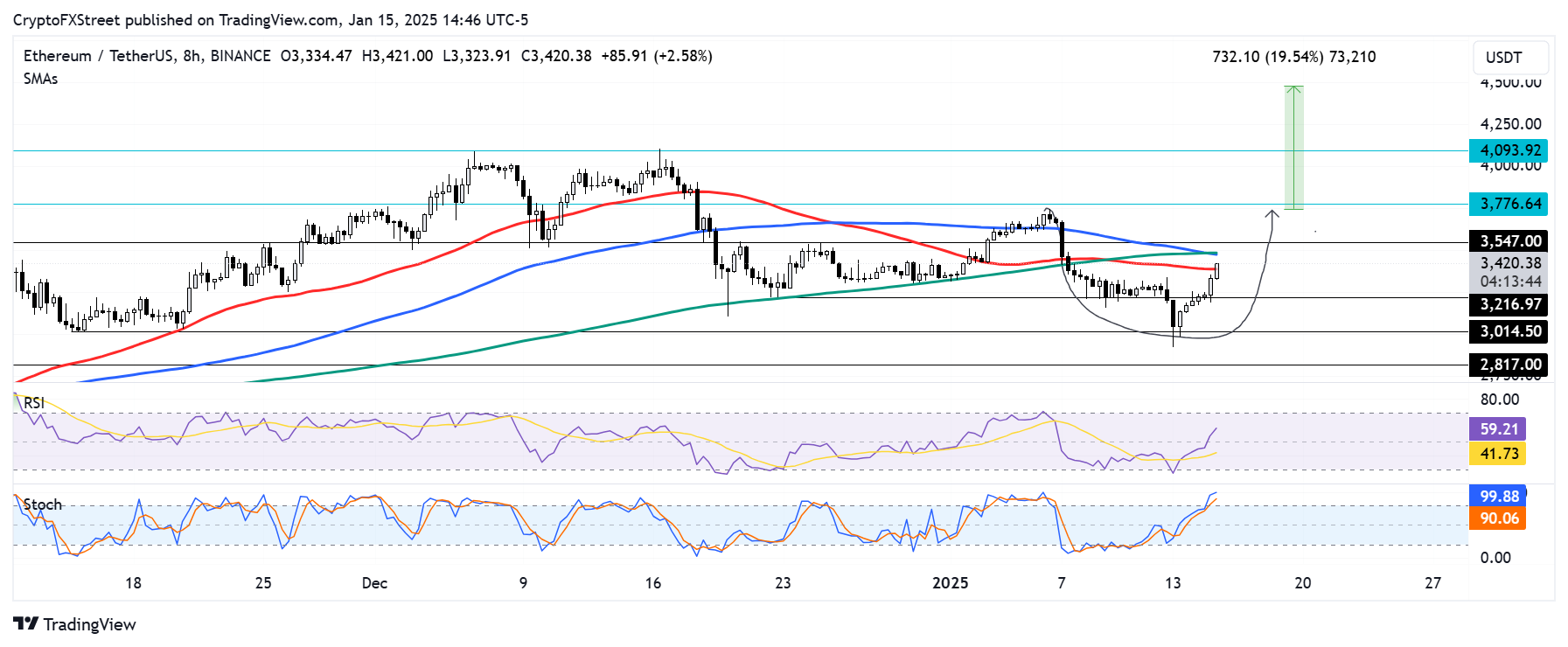Ethereum Price Forecast: ETH could rally above $4,400 despite increased staking withdrawals
Ethereum price today: $3,440
- Ethereum investors withdrew a net 160,000 ETH from staking contracts in the past four days.
- Ethereum ETFs broke their outflow streak, but minor inflows indicate doubt is still dominant among institutional investors.
- ETH could rally above $4,400 if it validates a rounded bottom pattern by clearing the resistance levels near $3,550 and $3,770.
Ethereum (ETH) is up above 5% on Wednesday as market participants reacted positively to the US Consumer Price Index (CPI) data release. Despite increased staking withdrawals and disappointing ETF flows, Ethereum could rally above $4,400 if it validates a rounded bottom pattern.
Ethereum staking and ETF flows disappoint
Ethereum joined the general crypto market in its rally after the US release of lower-than-expected core CPI data triggered buying activity across risk assets. While optimism is slowly returning to the market, ETH staking flows have yet to improve.
In the past four days, the total amount of staked ETH plunged by 160,000 ETH before rising slightly on Tuesday.
This adds to the growing trend of increased staking withdrawals that began in November when the crypto market began rallying following Donald Trump's presidential election victory. Since then, Ethereum staking contracts have seen a decline of nearly 800,000 ETH.
-638725683242813498.png)
Ethereum Total Value Staked. Source: CryptoQuant
Meanwhile, Ethereum ETFs broke their four-day outflow streak after recording $1.2 million in inflows on Tuesday, per Coinglass data. Despite the recent recovery in the crypto market, the low inflows suggest that institutional investors remain skeptical about whether the bearish pressure has truly lifted.
Ethereum Price Forecast: ETH could rally above $4,400 if it validates rounded bottom pattern
Ethereum has seen $46.46 million in liquidations in the past 24 hours. The total amount of liquidated long positions accounted for $11.27 million, while short liquidations crossed $35.19 million.
The top altcoin is attempting to move above the resistance level near the 50-day, 100-day and 200-day Simple Moving Averages (SMAs). A move above this hurdle could strengthen ETH to overcome the key resistance levels near $3,550 and $3,770.

ETH/USDT 8-hour chart
If ETH clears these key resistance levels, it will validate a rounded bottom pattern that could see the top altcoin rallying to a three-year high above $4,400. However, bulls have to outweigh the historical sell pressure near ETH's 2024 high just below $4,100 for this move to materialize.
The Relative Strength Index (RSI) has crossed above its neutral level, indicating rising bullish momentum. However, the Stochastic Oscillator (Stoch) is in the overbought region, indicating ETH could likely see a correction.
A daily candlestick close below the $2,817 support level will invalidate the bullish thesis and send ETH toward $2,200.
Ethereum FAQs
Ethereum is a decentralized open-source blockchain with smart contracts functionality. Its native currency Ether (ETH), is the second-largest cryptocurrency and number one altcoin by market capitalization. The Ethereum network is tailored for building crypto solutions like decentralized finance (DeFi), GameFi, non-fungible tokens (NFTs), decentralized autonomous organizations (DAOs), etc.
Ethereum is a public decentralized blockchain technology, where developers can build and deploy applications that function without the need for a central authority. To make this easier, the network leverages the Solidity programming language and Ethereum virtual machine which helps developers create and launch applications with smart contract functionality.
Smart contracts are publicly verifiable codes that automates agreements between two or more parties. Basically, these codes self-execute encoded actions when predetermined conditions are met.
Staking is a process of earning yield on your idle crypto assets by locking them in a crypto protocol for a specified duration as a means of contributing to its security. Ethereum transitioned from a Proof-of-Work (PoW) to a Proof-of-Stake (PoS) consensus mechanism on September 15, 2022, in an event christened “The Merge.” The Merge was a key part of Ethereum's roadmap to achieve high-level scalability, decentralization and security while remaining sustainable. Unlike PoW, which requires the use of expensive hardware, PoS reduces the barrier of entry for validators by leveraging the use of crypto tokens as the core foundation of its consensus process.
Gas is the unit for measuring transaction fees that users pay for conducting transactions on Ethereum. During periods of network congestion, gas can be extremely high, causing validators to prioritize transactions based on their fees.

